Take Control of Your Time
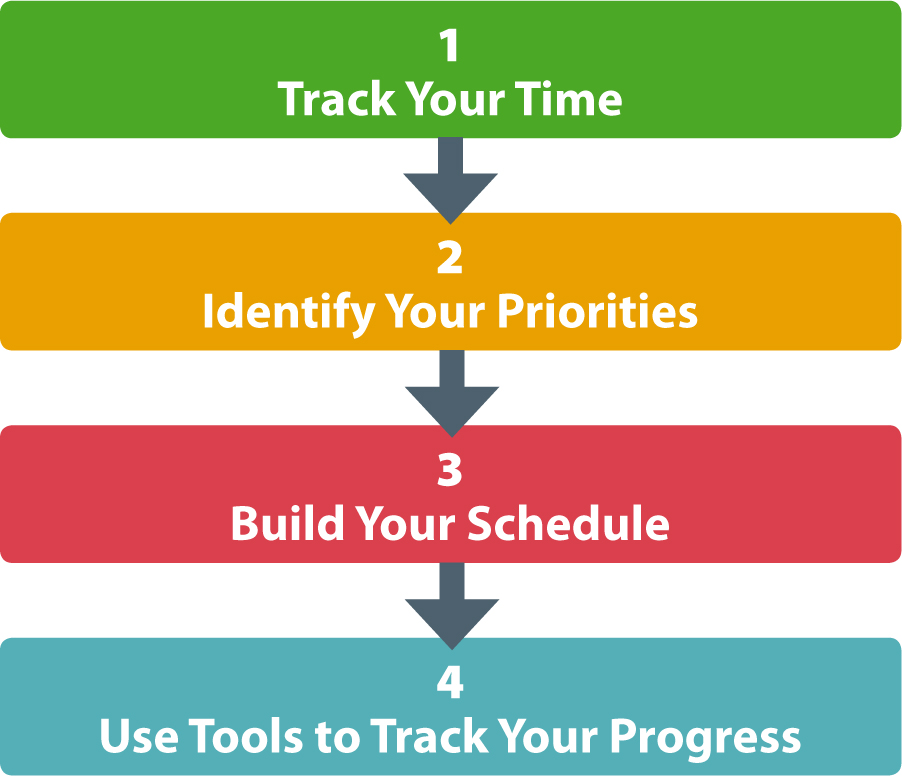
Organizing your class materials is a great first step, but to really set the stage for success in college and work, you also have to take control of your time. To see why these two skills make a powerful combination, picture yourself in the following two scenarios.
Scenario 1: You check your calendar and see that you’ve planned to spend two hours tonight working on a paper that’s due in four days. You walk into your study space, pull the exact course materials you need from a shelf, and sit down to begin working. Clearly, you’ve organized your course materials and taken control of your time.
Scenario 2: You never scheduled time to work on an assigned paper. The night before it’s due, you suddenly remember that you haven’t even started on it. You paw through a mound of papers on your desk, searching for the syllabus to see what the assignment is. When you finally find it and read the instructions, you realize that you’re unprepared and have little hope of finishing the paper on time. You’re so stressed out that you try to distract yourself by playing your favorite online game. An hour slips by before you force yourself to start working on the paper.
What can you do to avoid scenario 2? Get organized using the strategies in this chapter, and master the art of time management using the four-step process shown in Figure 5.1: First, track your time, by documenting how you spend your time during the course of a week. Second, identify your priorities — the activities that matter most to you — based on your values and goals. Third, build a schedule that focuses on your priorities. And fourth, use tools to track your progress on all of your assignments.
Let’s explore each of these steps in detail.
Step 1: Track Your Time
If you’re like most college students, you sometimes (maybe even often) feel as though you have too much to do and not enough time to do it. That’s not surprising: You’re probably juggling lots of different demands, such as going to class, caring for kids or elderly parents, or holding down a job. If you’re just out of high school, you might also be setting your own schedule for the first time, a responsibility that can feel overwhelming. Whatever your situation, before you can take control of your time, you have to figure out where your time is currently going. What do you actually do as the hours tick by every day?
To get a complete picture of how you’re spending your time, you need to record — in writing — what you do every day and how long each activity takes. Why bother writing all this down? Your perceptions about how much time you spend on daily activities could be quite different from reality. By recording specifics, you’ll build a more accurate picture of where your time goes.
To begin, use a calendar or write down on a piece of paper exactly what you do each day and how long each activity takes (see Figure 5.2). Do this for an entire week. As you collect this information, ask yourself:
What activities are taking up most of my time?
Am I spending too much time on unproductive or distracting activities? If so, what are they?
When am I most productive? Least productive?
Then give your critical thinking skills a workout: Examine the patterns you see in your time tracker, and analyze your responses to the questions. Use all this information to draw conclusions about how you’re spending your time and how you might manage it more effectively. For example, let’s say that before you started this exercise, you believed that your many obligations left you little time to study. As you evaluate the information you’ve gathered, you realize that you spent twenty-five hours gaming. Because you’re studying English literature, not video-game design, you conclude that you could (and should) free up time to study by cutting back on your gaming. You’ve uncovered a wealth of time that you didn’t realize was available.
Once you understand where your time is going, you can start thinking about better ways to allocate it. After all, there are only so many hours in a day (and a night). It’s up to you to spend this precious resource wisely.
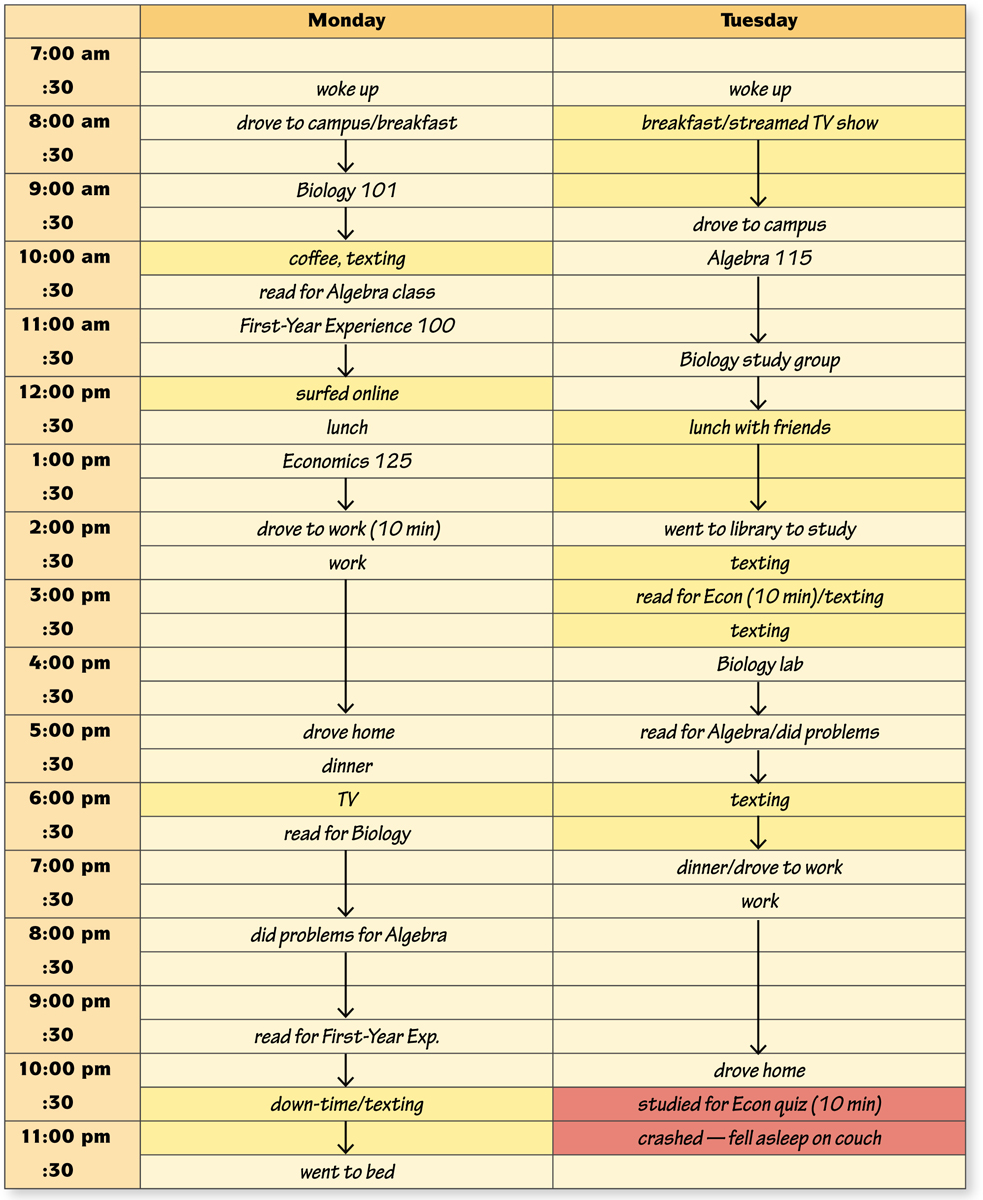
Step 2: Identify Your Priorities
Once you’ve tracked your time for a week and analyzed the results, consider whether you’re allocating enough time to the things that matter to you most. Are trivial tasks eating up too many hours each week? Does your current use of time reflect how important your education is to you? With numerous obligations and activities competing for your attention, you have to make choices about where to focus your energies. In other words, you have to prioritize your commitments and use these priorities to decide how much of your time an activity deserves.
Prioritize: To give an activity or a goal a higher value relative to another activity or goal.
Prioritizing commitments is a deeply personal process that depends on your values and goals. For one person, earning a degree while also spending time with family may be top priorities. For another person, completing college and getting a promotion at work may be most important. When you’re clear about your priorities, you make smarter choices about how to use your time. For instance, if doing well in your classes is a top priority, you’ll probably choose to study for an exam the night before, instead of going out with friends who don’t have a test tomorrow.
To practice prioritizing, review your one-week time tracker, and write down the activities that currently take up most of your time (see Figure 5.3). Describe these activities in broad terms, such as “attending class,” “studying,” and “working.” Determine how important each activity is to you personally, and indicate that importance using the following four-point scale:
4 = critically important
3 = highly important
2 = moderately important
1 = of little or no importance
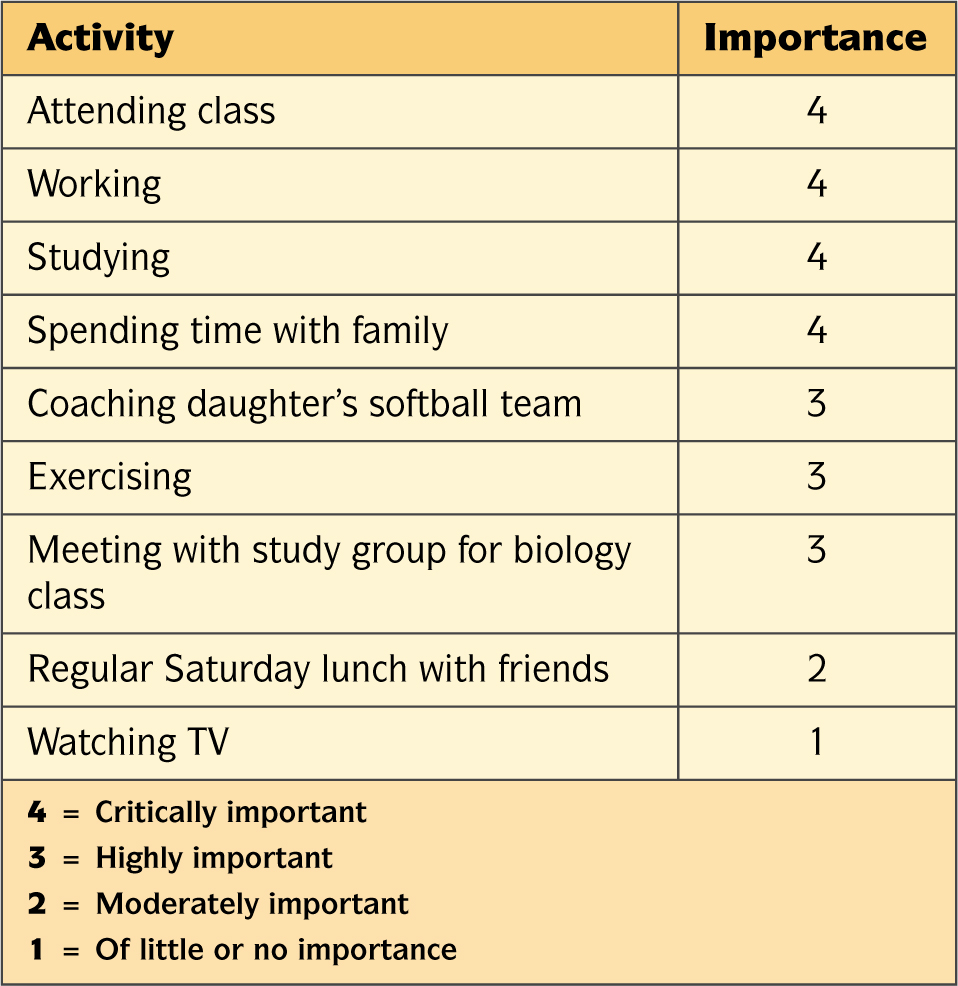
Critically important activities (those you’ve rated 4) are those that you’ve decided you must do because they relate directly to your values and responsibilities. For instance, each week you may need to go to work, attend all of your classes, and be home by 3:00 p.m. when your children get off the bus. Highly important activities (rank = 3) will also have an impact on your success — such as doing five extra problems for math each evening. Activities you’ve rated 4 and 3 may not always be fun or exciting, but you consider them crucial for achieving your goals or living your values. Activities you view as moderately important (rank = 2) or of little or no importance (rank = 1) are less essential to your values or goals.
To define your priorities, you need to think critically about what’s most important to you. And to honor your priorities, you sometimes have to make tough decisions, such as giving up activities that you enjoy or disappointing someone who wants some of your time. For example, what if your niece’s school play is the same day as your statistics exam? What if your boss needs you to work Tuesday night, but you’re supposed to meet with several classmates from your history course to start a group project? These kinds of choices are never easy, but we all face them and have to learn how to manage them. If you know what your priorities are, you can make the tough calls and be at peace with your decisions.
Step 3: Build Your Schedule
Once you’ve tracked your time and clarified your priorities, you can build a schedule that reflects the most important commitments in your life. Find a scheduling method and tools that work for you — whether it’s a paper planner, an app on your phone, a calendar tied to your e-mail system, a calendar hanging in your kitchen, or a mix of these. You can also create schedules that cover different time frames — terms, months, weeks, and days. (For an example of a five-day schedule, see Figure 5.4.)
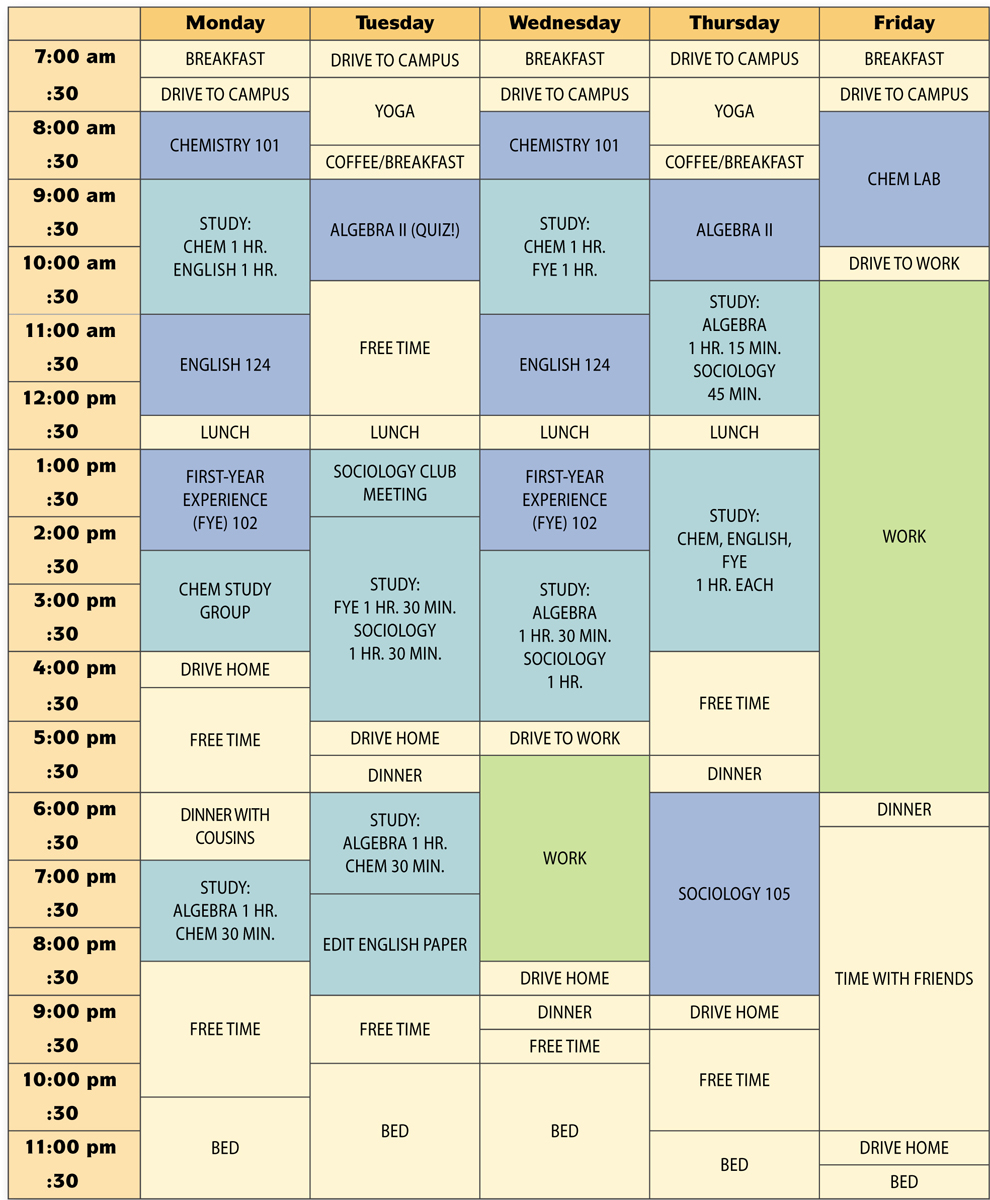
CONNECT
TO MY RESOURCES
Many time-management apps are available for smartphones and tablets. Find the three highest-rated options in the Apple or Android app store. Write a pros-and-cons list for each one; then try out your preferred option for a week. In writing, explain how well this tool worked for you. Will you use it again?
The activities you put on your schedule will depend on your priorities, but because you’re in college, we assume that one of your top priorities is graduating. So you’ll need to think about and plan for the following responsibilities:
Classes. Include class time in your schedule. If your class is on campus rather than online, plan to arrive a few minutes early so that you can get settled and prepare to learn.
Study time. Set aside two hours of study time for each hour of class time. The most common college class format is about three hours of class time a week, which involves six hours of studying outside of class. If you’re taking four three-hour classes this term, you should budget twelve hours of class time and twenty-four hours of study time each week. Research shows that full-time students spend an average of a little less than fifteen hours per week studying.2 That’s not nearly enough time. If you can find two hours to study for each hour of class time and if you use that study time wisely, you’ll likely get much better grades than students who invest less time in studying. Also, arrange your study time in a way that maximizes your learning. Spacing out your study time across multiple days and studying in small blocks of time is the most productive way to learn new material.3
Exams and assignments. In your schedule, include the time needed to take exams, to complete regular assignments and major projects, and to develop presentations for class.
Work. Add your work hours to your schedule. If you commute between home, work, and school, factor in travel time.
Family. Include high-priority family time in your schedule, such as having dinner together each evening or blocking off an afternoon to celebrate a loved one’s birthday. These relationships can be a source of support as you manage the many demands of being a college student.
School events. Schedule time for high-priority events at school, such as attending tutoring sessions and study groups for difficult classes, going to important cultural events, or participating in student organizations. While it can be difficult for busy students to make time for these activities, it’s worth it: Active involvement on campus can strengthen your commitment to college and help you develop teamwork and communication skills.
Exercise and leisure. To do well in college, you have to be healthy — both physically and mentally. So be sure to schedule time for regular exercise and leisure activities to balance out the great amount of time and effort you’ll be devoting to your coursework.
Rewards. Schedule time to reward yourself for your successes in college. For instance, schedule a movie with friends or family members the night after an exam. These rewards don’t have to consume a lot of time, but they can help recharge your batteries so you can stay motivated for another round of hard work at school.
ACTIVITY: Ask students to create a rewards list for sticking to their schedule. These can be small daily rewards, such as watching a favorite TV show; weekly rewards, such as downloading a new song; or monthly rewards, such as going to a movie.
As you create your schedule, try to build some flexibility into it, in case something goes wrong. For instance, suppose you commute to school, and one of your classes starts at 8:30 a.m. on Tuesdays and Thursdays. You know traffic can be heavy at that time, so when you schedule time for commuting on those days, you add a “cushion” in case you get stuck in traffic. Or let’s say you’re scheduling time to study for a final exam. You pencil in a few hours of study on an alternative night, in case an emergency comes up and you can’t study on the original night you planned for. When you build flexibility into your schedule, you can shift gears more easily if surprises come up. If you schedule your time too tightly, it will be much harder to make these adjustments.
ACTIVITY: Prior to class, create an imaginary student and a list of tasks the student must complete during the week. Divide students into small groups, and ask them to schedule this student’s week, similar to the format in Figure 5.4. While students are working, add a new, unexpected event to the schedule, underscoring the need to be flexible.
Step 4: Use Tools to Track Progress on Your Projects
Tracking your progress helps you evaluate how effectively you’re managing the time allocated to your priorities. By doing this, you hold yourself accountable, or responsible, for completing the tasks and meeting the obligations that are connected to your priorities. Here are some tools that can help you keep your projects on track and help you meet your goals.
Accountable: Responsible for completing tasks and meeting obligations.
Project Plan. Your schedule will include time to work on major school projects, and when you create a project plan, you can track your progress on each of these projects. A project plan helps you break down an assignment into smaller, more manageable steps and budget time to complete each step. This tool builds on key concepts in the chapter on thinking critically and setting goals, such as identifying action steps, prioritizing them, and giving each step a deadline. To create a project plan, you estimate how much time will be required to complete each step in the project. That way, you can build enough time into your schedule to complete all the steps by the assignment’s due date.
Consider Mia, who has six weeks to write a major paper on Greek architecture. Figure 5.5 shows how Mia has broken down the tasks involved in completing this paper. She starts with the due date and adds a goal statement for this assignment. She lists the steps needed to complete her paper. Since Mia is a new college student, she isn’t sure how much time each task will take, but she wrote papers in high school and often pulls together documents for her boss. She draws on these experiences to estimate how much time she’ll need for each task.
CONNECT
TO MY CAREER
In many careers, people have to manage projects, write reports, or complete major assignments. Explain how you might use a project plan to manage a project in your current job or, if you’re not currently working, a project that you may have to do in a career you’re considering.
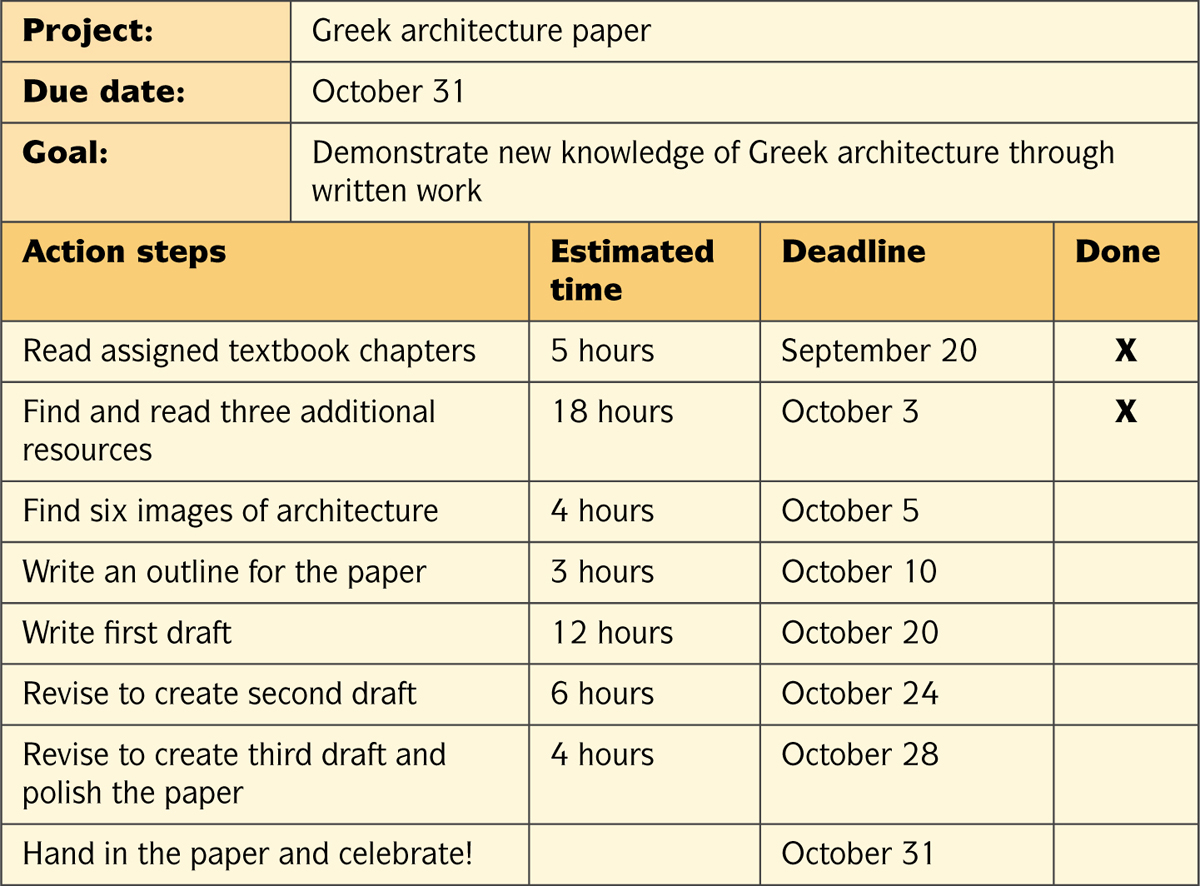
One advantage of creating a project plan is that you can use the deadlines in your plan to hold yourself accountable. Also, crossing off tasks as you complete them gives you a feeling of accomplishment, which can be crucial for maintaining momentum throughout the project.
To-Do List. A to-do list helps you manage time and activities on a daily basis, by reminding you of key tasks (see Figure 5.6). For example, in the Student Voice of Experience later in this chapter, Amni lists the tasks she wants to complete each day and crosses them off as she finishes them.
CONNECT
TO MY EXPERIENCE
Think about everything you have to accomplish tomorrow, and create a to-do list — either just before you go to bed tonight or just after you get up tomorrow morning. What are your main tasks for the day?
Try creating a to-do list for the next day each night before you go to bed or for the current day when you get up in the morning. It takes only a couple of minutes. You can make your list using an e-mail program, the calendar on your smartphone, apps on your tablet, or a piece of paper. Experiment with color-coding or numbering the tasks on your to-do list by priority. Try different methods to discover which strategies work best for you.

Manage Time in Your Online Classes
If your schedule includes online classes, keep in mind that they sometimes present unique time-management challenges. Your traditional courses are scheduled on particular days and times, and you can block off this class time in your schedule. With many online classes, though, the time you spend participating in class is less structured. Most online courses don’t require you to attend at any specific time, so deciding when you’ll create and respond to online posts and complete other course requirements is up to you. In addition, while some students expect online classes to be easier or less intensive than face-to-face courses, most online classes take as much time as do in-person classes (and sometimes even more time). So be sure to schedule enough time to complete your assignments. Try these tips for staying on top of your online coursework.
WRITING PROMPT: Invite students to schedule their online classes as they would their face-to-face classes. For example, a traditional class may meet every Monday, Wednesday, and Friday from 11:00 a.m. to 12:00 p.m. in the same classroom. Have students pick a time and “classroom” (such as the library or a coffee shop) to “attend” their online class. Then ask students to explain their selections in writing.
Get comfortable with this class format. If you’re new to online classes, block out time in your schedule to learn how to navigate the online class system. Your instructor and institution can help.
Devote time each week to work on your assignments. Be sure that your weekly schedule includes time for studying, reading, and posting work online for your class. Creating a consistent schedule is particularly critical to mastering course material for online classes.
Log in to your online class each day. Even if it’s just for five minutes, log in to check for updates from your instructor or posts from other students. That way, you can make sure you’re keeping up with assignments and monitoring class discussions.
Know your deadlines. If your instructor gives specific due dates for class assignments, enter them into your schedule for each week of the term.
Schedule time for live meetings hosted by your instructor. Sometimes hosted via tools like Skype or a text chat, live meetings give you opportunities to interact with classmates and instructors in real time.

voices of experience: student
TOOLS FOR TIME MANAGEMENT

| NAME: | Amni Al-Kachak |
| SCHOOL: | University of California, Irvine |
| MAJOR: | Biological Sciences |
| CAREER GOAL: | Ph.D. in Biological Sciences |
“I can’t live without schedules and lists.”
When I started college, I knew I’d have to work even harder than I did in high school. To be proactive, I started a scheduling system; now I can’t live without schedules and lists. I make special timelines that include goals and when I want them done by. I make a list for the year, a list each week, and a daily list and keep them all on paper. Seeing it written down makes it feel more achievable for me, and I love the feeling I get when I can cross something off my list!
I’ve always believed that academics come first, then work, then fun. Whenever I schedule things, I put them in that order. For example, if I have a homework assignment due, I get it done first. After that, if I have any work for my job that needs to get done, I’ll do that. Then, if I’m done with my immediate academic and work priorities, I squeeze in study time. I like to make a habit of studying every day, just so the information stays fresh in my head without having to stressfully cram it in during test time. After I’ve completed all of the tasks on my list, I can reward myself by having fun with my friends. I always do things according to deadline and importance.
It can be hard to stick to my schedule. One day I was reading my biology textbook, but then my friend texted me. We started a conversation that lasted for about an hour. Because I’m so aware of my time, I felt really guilty because I could have spent that hour doing a million things. From then on, I decided to put my phone away while I was studying. Although the work I’m doing may be difficult or boring, I’m much happier with myself if I focus and get it done instead of procrastinating.
YOUR TURN: Do you have strategies you use to stay focused on your top priorities? If so, what’s an example of a strategy you’ve found helpful? If not, which of Amni’s strategies might be useful to you?